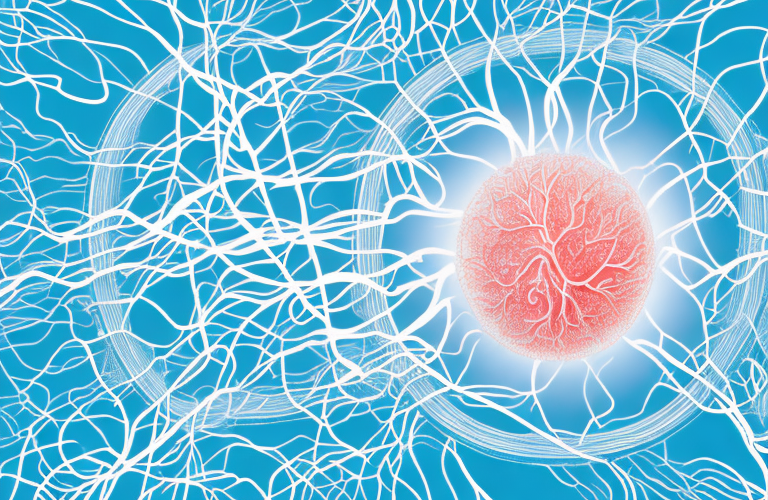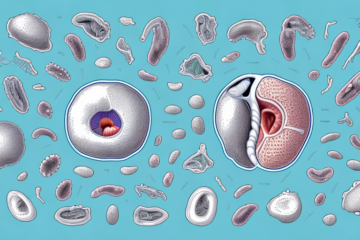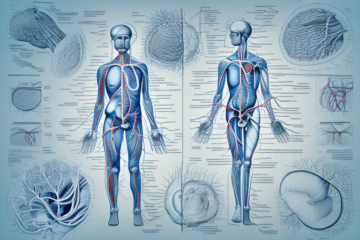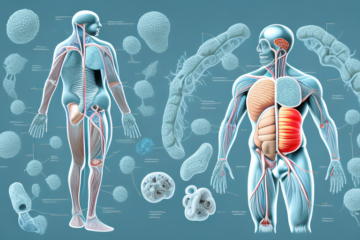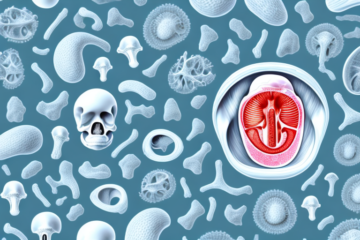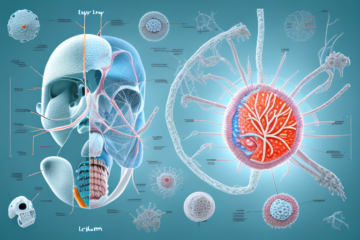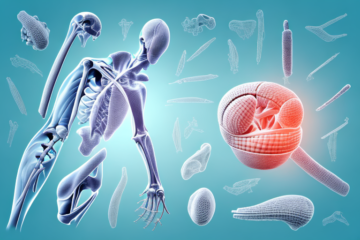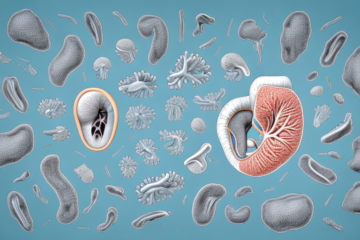Capillaries are one of the most important components of our circulatory system. They are the smallest blood vessels in our body, responsible for carrying blood from the arteries to the veins. In this article, we will explore the anatomy, function, and importance of capillaries and discuss some common diseases affecting capillary function and ways to maintain healthy capillaries.
What Are Capillaries?
Capillaries are thin, tubular structures that are just one cell thick. They are the smallest blood vessels in our body, measuring only a few microns in diameter. Capillaries are responsible for the exchange of nutrients, oxygen, and waste products between blood and tissues. They are present in almost all vascularized organs, including skin, muscles, and internal organs, and form a complex network that connects arterioles and venules.
Capillaries are also important in regulating blood flow and blood pressure. The diameter of capillaries can change in response to various stimuli, such as hormones or local tissue needs. This allows for precise control of blood flow to different areas of the body. Additionally, capillaries play a crucial role in the immune system by allowing white blood cells to leave the bloodstream and enter tissues to fight infections.
The Role Of Capillaries In The Circulatory System
The circulatory system is responsible for delivering oxygen and nutrients to the organs and tissues of our body. Capillaries play a critical role in this system by facilitating the exchange of gases, nutrients, and waste products between blood and tissues. Oxygenated blood flows through the arterioles and enters the capillaries, where it diffuses into the surrounding tissues. Similarly, waste products and carbon dioxide are removed from the tissues and transported back to the heart through the veins.
Capillaries are the smallest blood vessels in the body, with a diameter of only a few micrometers. They are so small that red blood cells can only pass through them in single file. This allows for efficient exchange of gases and nutrients between the blood and tissues. Capillaries are also highly permeable, meaning that they allow for the passage of small molecules such as glucose and oxygen, while preventing larger molecules like proteins from escaping into the tissues.
In addition to their role in gas and nutrient exchange, capillaries also play a crucial role in regulating blood flow and blood pressure. The smooth muscle cells that surround capillaries can contract or relax in response to signals from the nervous system or local chemical signals. This allows for precise control of blood flow to different tissues and organs, ensuring that they receive the appropriate amount of oxygen and nutrients to function properly.
Anatomy Of Capillaries: Structure And Size
Capillaries consist of a single layer of endothelial cells, which form a thin, permeable barrier between blood and tissues. The wall of the capillary is so thin that molecules can easily pass through it. The size and structure of capillaries vary depending on their location in the body. Some capillaries have small holes in their walls to allow for the exchange of larger molecules, while others are completely impermeable to certain substances.
Capillaries are the smallest blood vessels in the body, with a diameter of only 5-10 micrometers. They are responsible for delivering oxygen and nutrients to tissues and removing waste products. Capillaries are found in almost every tissue in the body, including muscles, organs, and the brain. The number of capillaries in a tissue is directly related to its metabolic activity, with highly active tissues having a greater density of capillaries.
Types Of Capillaries: Continuous, Fenestrated, and Discontinuous
There are three main types of capillaries: continuous, fenestrated, and discontinuous. Continuous capillaries are the most common type, and they allow for the exchange of small molecules such as oxygen and carbon dioxide. Fenestrated capillaries have small holes in their walls and are found in organs that require a higher exchange of nutrients, like the kidneys and small intestine. Discontinuous capillaries are found in the liver and bone marrow and have large gaps in their walls that allow for the transport of large cells and proteins.
Continuous capillaries are further divided into two subtypes: those with tight junctions and those with loose junctions. Tight junctions are found in the brain and prevent the passage of large molecules and cells, while loose junctions are found in the skin and muscles and allow for the passage of larger molecules.
In addition to their role in nutrient and gas exchange, capillaries also play a crucial role in regulating blood pressure. The constriction and dilation of capillaries can affect the resistance to blood flow and ultimately impact blood pressure. This is why medications that target capillary function, such as vasodilators, are commonly used to treat hypertension.
How Capillaries Work: Exchange Of Nutrients And Waste Products
Capillaries work by facilitating the exchange of nutrients, gases, and waste products between blood and tissues. The process is driven by a concentration gradient, meaning molecules move from areas of high concentration to areas of low concentration. Oxygen, for example, moves from the capillary into surrounding cells because there is a higher concentration of oxygen in the blood than in the tissue. At the same time, waste products like carbon dioxide, move from the cells into the blood. This exchange of molecules continues until the concentration levels equalize on both sides of the capillary wall.
Capillaries are the smallest blood vessels in the body, with a diameter of only a few micrometers. They are responsible for delivering oxygen and nutrients to tissues and removing waste products. Capillaries are so small that red blood cells must pass through them in single file, allowing for efficient exchange of molecules.
The walls of capillaries are made up of a single layer of endothelial cells, which are thin and permeable. This allows for easy diffusion of molecules between the blood and surrounding tissues. Capillaries are also surrounded by pericytes, which help regulate blood flow and maintain the integrity of the capillary wall.
Importance Of Capillaries In Oxygen Delivery To Tissues
Capillaries play a critical role in delivering oxygen to our body tissues. Without adequate oxygen delivery, tissues and organs can become damaged, leading to a range of health problems. The capillary network is designed to deliver oxygen-rich blood to every part of the body and ensures that even the most remote cells have access to nutrients and oxygen. In the lungs, for example, oxygen diffuses from the atmosphere to the alveoli, where it enters the blood and is transported by capillaries to every part of the body.
Capillaries are also important in the removal of waste products from tissues. As blood flows through the capillaries, it picks up waste products such as carbon dioxide and transports them to the lungs for removal. Additionally, capillaries in the kidneys filter waste products from the blood and excrete them in urine. Without capillaries, the body would not be able to efficiently remove waste products, leading to a buildup of toxins and potential health problems.
Factors That Affect Capillary Function: Blood Pressure and Blood Flow
Capillary function can be affected by a number of factors, including blood pressure and blood flow. High blood pressure can put pressure on the walls of the capillaries, making it harder for blood to flow through them. Reduced blood flow can also limit the amount of oxygen and nutrients that reach the tissues. To maintain healthy capillaries, it’s important to keep blood pressure within normal limits and engage in regular physical activity to improve blood flow.
In addition to blood pressure and blood flow, other factors that can affect capillary function include age, smoking, and certain medical conditions such as diabetes and heart disease. As we age, our capillaries become less elastic and may not function as efficiently. Smoking can also damage the walls of the capillaries, making it harder for blood to flow through them. Medical conditions that affect the cardiovascular system can also impact capillary function, as they can affect blood pressure and blood flow. It’s important to maintain a healthy lifestyle and manage any medical conditions to support optimal capillary function.
How To Maintain Healthy Capillaries: Diet And Exercise Tips
Eating a healthy diet rich in fruits, vegetables, and whole grains can help improve capillary health. Vitamins C and E are particularly important for maintaining healthy capillaries, as they help to strengthen blood vessel walls and reduce inflammation in the body. Regular exercise is also crucial for ensuring good capillary function. Engaging in activities that increase blood flow, like walking, cycling, or swimming, can help keep capillaries healthy and improve overall cardiovascular health.
In addition to diet and exercise, there are other lifestyle factors that can impact capillary health. Avoiding smoking and excessive alcohol consumption can help prevent damage to blood vessels and improve circulation. Managing stress levels through techniques like meditation or yoga can also have a positive effect on capillary function. It’s important to prioritize overall health and wellness in order to maintain healthy capillaries and prevent potential health issues in the future.
Common Diseases Affecting Capillary Function: Hypertension, Diabetes And More
Several diseases can negatively affect capillary function, including hypertension, diabetes, and atherosclerosis. Hypertension can lead to weakened capillary walls and reduced blood flow to the tissues. In diabetes, high blood sugar levels can damage the endothelial cells that make up the capillary walls, leading to reduced blood flow and poor oxygen delivery to the tissues. Atherosclerosis, or hardening of the arteries, can also impair capillary function by narrowing the blood vessels and making it harder for blood to flow through them.
Other diseases that can affect capillary function include Raynaud’s disease, which causes spasms in the blood vessels and reduces blood flow to the fingers and toes, and lupus, an autoimmune disease that can cause inflammation and damage to the capillaries. Additionally, certain medications, such as chemotherapy drugs, can also have negative effects on capillary function. It is important to manage these conditions and work with a healthcare provider to prevent further damage to capillaries and maintain overall health.
Diagnosis And Treatment Of Capillary Disorders: Medications, Surgery And Lifestyle Changes
Diagnosis and treatment of capillary disorders will depend on the underlying cause of the problem. Medications, like blood pressure-lowering drugs or medications to control blood sugar levels, may be prescribed to manage symptoms. Lifestyle changes, such as increasing physical activity and adopting a healthier diet, can also help improve capillary function. In severe cases, surgery may be necessary to repair damaged blood vessels or remove blockages.
It is important to note that capillary disorders can also be caused by certain medical conditions, such as autoimmune diseases or blood disorders. In these cases, treatment may involve managing the underlying condition in addition to addressing the capillary disorder itself.
In some instances, alternative therapies like acupuncture or herbal remedies may be used in conjunction with traditional medical treatments to help manage symptoms and improve overall health. However, it is important to consult with a healthcare professional before trying any alternative therapies to ensure they are safe and effective.
Future Research Directions For Understanding The Role Of Capillaries In Health And Disease
Despite their importance, much remains unknown about the role of capillaries in health and disease. Future research will likely focus on better understanding the mechanisms that regulate capillary function and identifying new treatments for diseases that affect capillary function. Advances in technologies like imaging and gene editing may also offer new insights into the role of capillaries in the body and help pave the way for new interventions to improve vascular health.
In conclusion, capillaries play a vital role in maintaining the health of our organs and tissues. From their anatomy and function to the ways they can be impacted by disease and lifestyle choices, understanding the complexities of capillary health is essential for maintaining overall cardiovascular health and preventing chronic diseases.
One area of future research that holds promise is the study of the gut microbiome and its impact on capillary health. Recent studies have shown that the composition of gut bacteria can affect the function of blood vessels, including capillaries. Understanding the relationship between the gut microbiome and capillary health could lead to new interventions for preventing and treating cardiovascular diseases.

